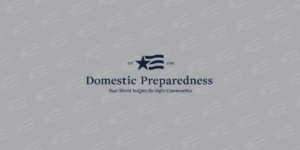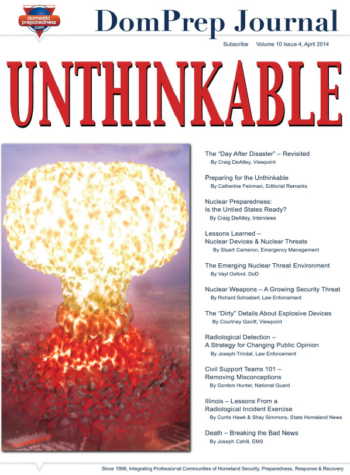
Preparing for the Unthinkable
Catherine L. Feinman
April 30, 2014
An article, a flash poll, and a podcast each addressed the same topic: Is the United States
prepared for a nuclear detonation? Each came to the same conclusion, “No, not as prepared as it needs to
be.” The threat of a nuclear attack did not disappear with the Cold War, but the lessons learned are
fading.

Nuclear Preparedness: Is the United States Ready
Craig DeAtley
April 30, 2014
To address the gaps and concerns revealed in a recent article and the flash poll, subject matter
experts who warned of the dangers in 2009 reunited five years later to address the issues that are still
as real now as they were five years ago. Although there have been some improvements, much more is still
needed.

Illinois - Lessons From a Radiological Incident Exercise
Shay Simmons and Curtis Hawk
April 23, 2014
When a radiological incident occurs, the consequences can be devastating. However, the frequency and probability of such incidents limit many jurisdictions from being fully prepared and trained. Illinois officials understand the threat and conduct annual exercises to ensure that jurisdictions in and around its nuclear facilities are ready for their potential emergency response roles.

Radiological Detection - A Strategy for Changing Public Opinion
Joseph W. Trindal
April 23, 2014
The use and acceptance of unmanned aerial vehicle (UAV) technology for the law enforcement community is changing, with a great potential for broader uses. By integrating radiation sensors with UAVs, law enforcement officers could better intercept suspected threats. However, the public is not yet “”sold”” on the concept of such UAV applications.

Civil Support Teams 101 - Removing Misconceptions
Gordon Hunter
April 23, 2014
A DomPrep report published in March 2014 revealed some misconceptions about a valuable resource
provided by the National Guard. Civil support teams provide no-cost assets to local jurisdictions for
incidents, trainings, and exercises. As threats and missions evolve, local agencies should be familiar
with all the tools in their toolboxes.

Digital Life in 2025
Domestic Preparedness
April 17, 2014
The world’s growing connectivity will change how and where people associate, gather, and share information. This Pew Research Center Report predicts that, by the year 2025, most people will tap into the Internet so

The Emerging Nuclear Threat Environment
Vayl S. Oxford
April 16, 2014
The changing conditions in the Middle East and North Africa, the withdrawal of troops from Afghanistan and Iraq, and the impact of Iran’s nuclear program each have serious national security implications. To mitigate the emerging nuclear threat, agencies at all levels of government should perform five critical actions.

The 'Dirty' Details About Explosive Devices
Courtney Gavitt
April 16, 2014
The 2013 Boston Marathon bombings caused confusion, frustration, and anger when race marshals
abruptly ended the event. The consequences, though, could have been much greater had the initial reports
been true. Knowing what makes a dirty bomb “dirty” is the first step to ensure the health and safety of
all those who are near the detonation.

The 'Day After Disaster,' Revisited
Craig DeAtley
April 8, 2014
In the first 72 hours following a nuclear blast, survivors would face many challenges –
communication, evacuation, sheltering, response, and incident command. Scenario 1 (Nuclear Detonation –
Improvised Nuclear Device) of the National Response Framework was depicted in the History Channel’s “Day
After Disaster” in 2009. Five years later, is the United States prepared?

Nuclear Weapons - A Growing Security Threat
Richard Schoeberl
April 2, 2014
Although there has not been another significant attack on U.S. soil since 9/11, the threat of terrorists acquiring materials to create weapons of mass destruction still exists. Leaders of countries around the world recently met to discuss the current nuclear and radiological threats and to develop preventive measures to secure the “”ingredients”” for nuclear bombs.






